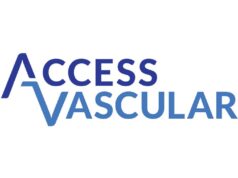 Access Vascular has announced that the company received 510(k) clearance from the US Food and Drug Administration (FDA) for its lead product, the HydroPICC, a peripherally inserted central catheter (PICC), intended for long-term use. In pre-clinical testing, the HydroPICC demonstrated a 30x reduction in platelet count when compared with current market-leading PICC.
Access Vascular has announced that the company received 510(k) clearance from the US Food and Drug Administration (FDA) for its lead product, the HydroPICC, a peripherally inserted central catheter (PICC), intended for long-term use. In pre-clinical testing, the HydroPICC demonstrated a 30x reduction in platelet count when compared with current market-leading PICC.
“The FDA clearance of the HydroPICC catheter is an important milestone for Access Vascular and a critical step forward on our pathway to commercialisation,” says James Biggins, founder, president and CEO of Access Vascular Inc, a medical device company focusing on venous access using proprietary material technology designed to reduce thrombus accumulation. “Our proprietary, unique technology does not flake or elude, and in vitro study results demonstrate our device’s ability to reduce thrombus accumulation as compared to currently available technologies. The reduction in thrombosis demonstrated in testing could have a significant and profound impact on the lives of millions of patients.”
Venous access devices are ubiquitous within the healthcare system. In the USA, over three million PICCs are placed every year to deliver drugs or nutrition to patients. Along with the benefits comes the significant potential of complications arising from the placement of a long-term catheter into a small caliber peripheral vein with multi-week indwell time. According to one study, 34% of PICCs placed will experience complications. These potential complications could significantly increase morbidity, hospital stay and overall cost of care.
“The risk of catheter thrombosis is significant and can often trigger a cascade of events leading to further complications,” adds Gary M Ansel, system medical chief, Vascular Services, Ohio Health Heart & Vascular Physicians and Access Vascular Medical Advisory board member. “The proprietary technology used in HydroPICC addresses many of the issues that arise with current venous access devices. By reducing thrombosis on the catheter, we may be able to lessen the risk of complications associated with blood clots, potentially improve outcomes and lead to improved “valued care” by positively impacting healthcare costs.”
To meet the anticipated demand for the device and to advance the development of their pipeline of venous access devices, Access Vascular is expanding its manufacturing and testing facility with an additional 4,000-square foot lab and manufacturing space and growing the commercial and manufacturing teams.












